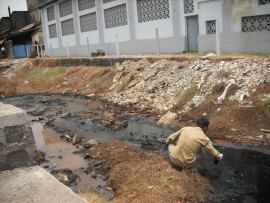Industrial Estates
Industrial estates are specific areas zoned for industrial activity in which infrastructure such as roads, power, and other utility services are provided to facilitate the growth of industries and to minimize impacts on the environment. Industrial estates are often located outside of major populated areas but poorly managed air emissions and wastewater discharges still have the ability to impact the environment and health of surrounding populations. The industrial uses and processes within estates vary widely, and thus the pollutants in each will vary as well. Like most pollution issues, a lack of strict enforcement has led to threatening environmental and health impacts in communities, primarily in LMICs.
Industrial estates are located all over the world and the sites are highly variable across many different countries. Currently, the Pure Earth database records that a majority of identified sites polluted by industrial estates are located in South Asia, mainly in India and Pakistan, although such estates are known to exist in many developing countries seeking to increase their manufacturing sector.
Industrial estates are linked with more than 100 of the contaminated sites in the Pure Earth’s database and pollutants from them potentially affect an estimated 5.8 million people near these sites. Industrial estates are estimated to contribute an estimated 390,000 to 1.06 million DALYs to the total disease burden in the 49 countries assessed. It should be noted that industrial estates release multiple and varied pollutants and this calculation of the burden of disease only examined known pollutants based on the Pure Earth’s database information. The largest contributor reported is lead but there is likely a much higher impact from the cumulative impact of combined pollutants not yet defined in our site investigations. As a result, this DALY calculation is very likely an underestimate.
Key Pollutants
Like many industrial sites, the primary contaminants of concern recorded are lead and chromium. The population at risk from lead and chromium in the industrial estates sources is estimated to be 1.2 million people. It is about 21 percent of the total number of 5.8 million people at risk from the industrial estates sector.
Exposure Pathways
Pollution at industrial estates is generally caused by a lack of appropriate waste processing infrastructure or pollution controls. Air pollution emissions, contamination of surface waters or aquifers that communities rely on for water, and improper disposal of hazardous wastes are prevalent at poorly managed and controlled estates. Industrial estates are sometimes located close to population centers but, alternatively, population centers often including squatter settlements grow near the estates due to availability of jobs. The World Bank Group recommends that industrial estates require systems for vapor recovery, sulfur recovery, recovery of waste, recycling of wastewaters, spill prevention and hazardous chemical and waste storage. These controls would reduce VOC emissions, sulfur emissions and the release of many toxic pollutants1.
Because of the high variability of activity at industrial estates, there are many ways in which pollutants can enter the environment. Industrial estates contain the types of industries that are covered elsewhere in this report, including lead smelting and processing, battery manufacturing and recycling, and chemical and product manufacturing. However, there are many additional types of industry processing that happens at industrial estates, complicating the identification, assessment and clean up. At polluted sites, general pathways for pollutants include wastewater, direct exposure to improperly disposed waste or sludge, and dust or emissions. Pathways for human exposure include inhalation of dust, dermal contact, food ingestion and water ingestion.




